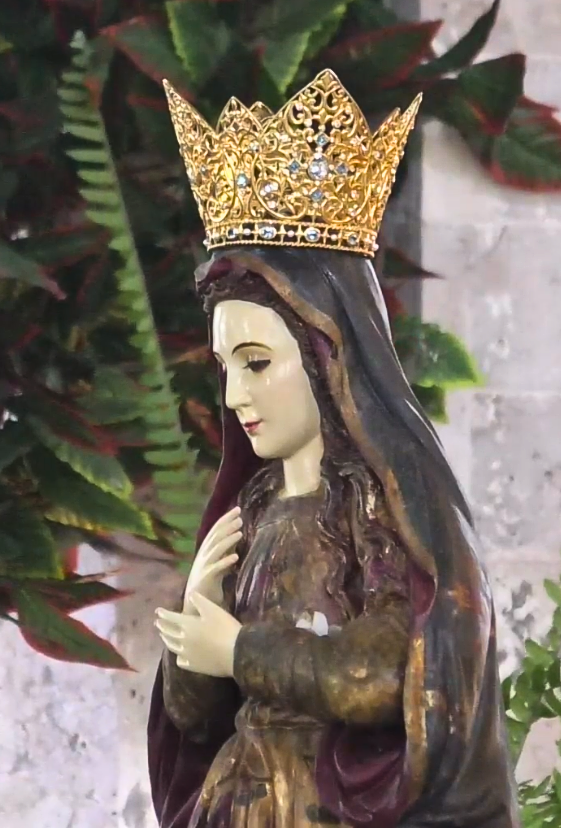
Within the historical paradise of Bohol, the faith of the Boholonos is kept alive through the ages. This is evident to the churches stands strong even after a devastating earthquake of 2010. One of the most notable Marian Shrines in Bohol is that of Our Lady of the Assumption in Dauis, Bohol where she is known for her astounding series of miracles over the years.
The Virgen de Asuncion de Dauis is one of the best known images of Bohol as one of its Miraculous Virgins along with the Nuestra Señora de la Luz (Birhen sa Kasilak) of Loon and VIrgen de Guadalupe de Extremadura of Loboc.
Features of the image

The de tallado image of the Virgin is that of the Assumption, as the title implied. However, upon looking at the feature of the image, the hands are together in prayer form, as if in contemplation which is unusual to the iconography of the Assumption where both hands are extended either upwards or downwards.
The face of the Virgin is of exquisite pensive beauty which the beholder will be struck with much awe and veneration. The image wears the diagnostic Doce Estrellas, a Crown, at times a resplendor. The Virgin is often vested with beautiful and simple regalias given by her devotees over the years.
History
The Recorded history of Dauis began with the arrival of the Jesuit priests, between 1697 – 1720. Since then, there was a succession of Jesuit missionaries until 1786 and were later replaced by the Augustinian Recollect fathers until 1888. Since then, Filipino priests have taken over the administration of the parish.

History is silent on where the image came from and who carved the image. During the 18th century, a tale was mentioned about a lady hailing from the town of Dalaguete in Cebu. She asked a banca drawer to ferry her to Mariveles (old name for Dauis). Afraid that the lady will not endure the rough sea conditions, the man refused the lady’s pleading. The lady kindly insisted that he’ll bring her to Mariveles, to which the man in the end agreed. She said she wanted to be near her husband. It was said that during the ride, the man did not experience turmoil in the seas. Instead, he felt that the boat that they were riding seemed to float in the air. When they were nearing Mariveles, he heard the lady spoke: “Duol na ang Mariveles” (Mariveles is near).

Docking near the church, the man turned his back to where the lady was seated. But to his amazement, the lady was no longer there. In her stead was a little camiseta, which he remembered the lady was brought during the trip. Startled, he hurried inside the then newly-built Dauis Church, only to be stunned once more when the lady showed semblance to the image of the Virgen de la Asuncion in the main altar. And true enough (as the lady previously said that she wanted to be near her husband), the Church of Dauis can be seen not far from the imposing church of St. Joseph in Tagbilaran City. This miracle is foretold in the Gozos in her honor and this event is commemorated every Last Sunday of January as a Secondary Feast.
Unfortunately, the original ivory head and jewels of the Virgin was sacrilegiously stolen in 1974 and a replacement head was immediately commissioned that can still be seen today.
The Church

The 18th century Dauis Church, dedicated to the “La Señora de la Asuncion” underwent so many changes starting from its inception when the first Spanish missionaries arrived in the town in 1697. The church was believed to be built of light materials. The church was consecrated by Bishop Juan Gorordo of Cebu on August 23, 1923. 61 years after Fr. Saldana laid its cornerstone, a cross was installed over the pediment in the year 1924. The convent constructed in 1884 was eventually renovated and utilized as Formation and Day Care Centers.

On August 24, 2004, the Parish of Our Lady of the Assumption was declared a Shrine honoring the patroness not only of Dauis but for the whole province of Bohol. In 2009, it was declared a National Historical Landmark while it was later named a National Cultural Treasure on August 29, 2011. On October 15, 2013, one of the largest earthquakes to hit Bohol struck the island severely damaging the centuries-old churches in Baclayon, Dauis, Dimiao, Loay, Loboc, Loon and Maribojoc. The church was severely damaged, however, the retablo where the Virgin was enshrined was miraculously spared.

In August 14, 2017, after much repairs were needed to the damaged church of Dauis, the Parish of Nuestra Señora de la Asuncion was formally re-opened to the faithful with much rejoicing. As of today, the pilgrimage to the Virgin of Dauis resumed and has grown over time.
The Miracles

The church of Our Lady of the Assumption is a center for Marian pilgrimages emanating from the different towns of Bohol. On certain occasions, the Tagbilaran faithful would go a long-distance pilgrimage from their city to the site to invoke special petitions or mainly to honor Our Lady of the Assumption.
The Virgin manifested abundant miracles through time, many petitions of her devotees are granted. Tales from time to time crop up that the patron saint’s attire is filled with amorseco, a vexing weed. The faithful believe that their Mother goes around Her domain as she watches over Her children. Dauis church is a pilgrimage site, with the pilgrims carrying empty containers to take home water from the miraculous well. On August 31, 1928, many young girls who were playing before the image of our lady seen her waving her hands as if bidding them to come near Her.

It is said that in the 1800s the Virgin reportedly weep copious tears that the devotees would wipe her face with a piece of cloth and keep them as mementos. Another story goes that she would visit a store to buy a few things that she would give to the poor families in town and the lady would resemble the Virgin at the altar.
The Miraculous Well

One of the most famous miracles of the Virgin is her famed miraculous well known for its healing properties that lie at the foot of the main altar. Local history tells that this well originated from the Spanish era. Pirates often attacked Christian settlements and it was during one such attack that the people took refuge behind locked doors of the church. Besieged by the enemy for days, the people run out of food and water.
The well miraculously sprang up and since then has become the source of drinking water for the populace nearby, especially during droughts. The water tastes truly fresh, despite the well’s closeness to the seashore. The waters of the well were tested and it shows no harmful chemicals found in the water and suitable for drinking. When samples of the water were sent for testing in Manila, chemists found that it was tested free from contaminants and heavy chemicals, which abound in well waters. Documented miracles have been published about the prodigious well water of Dauis which is akin to that of Lourdes, France.
In 2010 when a physician was totally healed of his terminal stage of liver cirrhosis after drinking the waters from the well of the Blessed Mother in Dauis. People flock to her shrine and bring home bottles of miraculous water and more cures are attributed to the Virgin’s help.
Ecclesiastical Recognition
For years, the Church gives distinct honors to the Virgin of Dauis with the declaration of the parish as the Diocesan Shrine of the Assumption of Our Lady in 2004. In 2021, The Diocesan Shrine of Our Lady of the Assumption was granted the privilege of Special Bond of Affinity with the Papal Basilica of Sancta Maria Maggiore in Rome, along with the shrines of Loboc and Loon. The declaration rites for the special bond took place on October 17, 2021.

In 2022, Pope Francis granted the Pontifical Coronation of Nuestra Señora de la Asuncion de Dauis, the first venerated Marian image in the Diocese of Tagbilaran and the Province of Bohol.
In preparation for the Coronation rites, the image underwent restoration under the supervision of the National Historical Commission of the Philippines. The Coronation rites took place on August 15, 2023 – the Solemnity of the Assumption of the Blessed Virgin Mary.
The Devotion at present

The Virgin of Asuncion de Dauis celebrates two feast days in her honor. First is the Solemnity of the Assumption every August 15 and a second Patronal feast is celebrated in the last Sunday of January to commemorate the legendary arrival of the Virgin to Dauis.
Devotees from as far as Dalaguete in Cebu province would often attend the virgin’s feast day every August 15th . It was from the Dalagueteños where stories of the lady’s sojourn and blessings were gathered. Up to this time, Dalagueteños continued to venerate and pay homage to Our Lady of the Assumption as a manifestation of their gratitude and appreciation after being healed of their ailments through the “camiseta”.
So we say, “Well then, why give glory and honor and devotion to Mary?” Because we do whatever Jesus tells us. And we do whatever Jesus does because the fundamental axiom of Christian morality is the imitacio Christi, the imitation of Christ, and he is the best of the best when it comes to being a son. Not only a Son of his heavenly Father but a Son of his earthly mother.

When he accepts the mission of his Father to become a man and to obey the law, he obeys it more perfectly than anybody could have ever imagined it being obeyed. And when he gets to that commandment, “Honor your father and your mother,” that Hebrew word, kabodah, means bestow glory, comes from kabod weight, glory. So he honors his Father and obeys his command by bestowing unprecedented glory upon the one that he has chosen from all eternity to be his mother. The only time that the Creator created a human creature, created the one destined to be his mother. And he filled her with his own life and grace because he began honoring as soon as she was created his mother
So what do we do? We honor Christ and we glorify him and we imitate him. If we really imitate him, we do what he does and we honor and bestow glory upon his mother. Not instead of him. It isn’t undermining devotion to Christ. It’s to express our devotion of Christ, our worship of Christ by imitating him. And if we do it we’re going to be able to see in her face, the face of our mother, because Jesus has taken on her flesh and blood and given us his own Divine nature. Peter says, “We are partakers of Divine nature through Christ” so that his mother can become our mother, spiritually, supernaturally, but actually and really. And so in devotion to him, we can be devoted to her without any compromise, without any tug of war, without any diminution or decrease of our honor to Christ.
References:
delos Reyes, Michael, “Place me with Your Son, The Jesuits and Filipino Marian devotion”, Jesuit Communications Foundation, Inc. Quezon City, 2021.
“Dauis”, Retrieved from https://en.wikipedia.org/wiki/Dauis on September 17, 2016.
“Miraculous Image of the Nuestra Señora dela Asuncion (Patroness of Dauis, Bohol)”, Retrieved from https://www.flickr.com/photos/28994831@N08/2781046948 on September 17, 2016.
Photos:
Atanacio, Jovi
Ballener, Harold
Diocesan Shrine and Parish of Assumption of Our Lady, Dauis, Bohol
